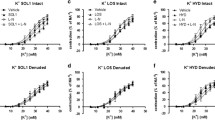Abstract
To investigate whether AT1 receptor antagonists are acting by increasing endothelium-dependent and-independent relaxation of aortas in normotensive rats, AT1 receptor antagonists, losartan and KR-30988, and angiotensin converting enzyme inhibitor, captopril, were orally administered for two weeks (50 mg/kg, b.i.d.). The blood pressure, heart rate and body weight were not significantly changed by losartan, KR-30988 and captopril compared to the control group. In aortic preparations, the pD2 of KR-30988 for ACh-induced relaxation was 8.33±0.16, significantly (p<0.05) lower than that of control group (7.71±0.15). ACh-induced relaxation was significantly increased in losartan-treated group (p<0.01) at 10−6 M of ACh, and in captopril-treated group (p<0.05) at the range of 10−7–10−5 M of ACh. The pD2 values for histamine-induced relaxation of losartan, KR-30988 and captopril were 5.57±0.10, 5.85±0.21 and 5.60±0.01, respectively, with significant differences in all groups (p<0.01) compared to that of control group (5.13±0.09). ACh-induced relaxations of aortic preparations were not changed by pretreatment of indomethacin (10−5 M), and completely blocked by pretreatment of L-NAME (10−5 M) in all groups. Sodium nitroprusside-induced relaxations were not significantly changed by all drugs tested in this experiments. These results suggest that AT1 receptor antagonists, losartan and KR-30988, enhance the endothelium-dependent relaxation on aortic preparations through the release of, or increase sensitivity, to nitric oxide in normotensive rats.
Similar content being viewed by others
References Cited
Antonaccio, M. J., Rubin, B. and Kotler, D., Effects of captopril on vascular reactivity of SHRin vivo andin vitro.Hypertension, 3, II-211–II-215 (1981).
Clozel, M., Mechanism of action of angiotensin converting enzyme inhibitors on endothelial function in hypetension.Hypertension, 18, II-37–II-42 (1991).
DeGraaf, G. L., Pals, D. T., Couch, S. J. and Lawson, J. A., Hormonal and cardiovascular effects of losartan (DuP753), an angiotensin receptor antagonist, in nonhuman primates.J. Pharmacol. Exp. Ther., 264, 6–10 (1993).
Fenoy, F. J., Milicic, I., Smith, R. D., Wong, P. C., Timmermans, P. B. and Roman, R., Effects of DuP 753 on renal function of normotensive and spontaneously hypertensive rats.Am. J. Hypertens., 4, 321S-326S (1991).
Gardiner, S. M. and Bennett, T., The effects of captopril on blood pressrue, urinary water and electrolyte excretion and drinking behaviour in Brattleboro rats.Clin. Sci., 65, 589–597 (1983).
Guan, H., Cachofeiro, V., Pucci, M. L., Kaminski, P. M., Wolin, M. S. and Nasjletti, A., Nitric oxide and the depressor response to angiotensin blockade in hypertension.Hypertension, 27, 19–24 (1996).
Lee, B. H. and Shin, H. S.,In vivo pharmacological evaluation of newly synthesized nonpeptidic AT1 receptor antagonists in rats.Arch. Pharm. Res., 17, 263–268 (1994).
Liao, D. F. and Chen, X., Prostacyclin-mediated protection by angiotensin-converting enzyme inhibitors against injury of aortic endothelium by free radicals.Caridioscience, 3, 79–84 (1992).
Luscher, T. F., Vanhoutte, P. M. and Raij, L., Antihypertensive treatment normalizes decreased endothelium-dependent relaxations in rats with salt-induced hypertension.Hypertension, 9, III193-III197 (1987).
Ohishi, K., Carmines, P. K., Inscho, E. W. and Navar, L. G., EDRF-angiotensin II interactions in rat juxtamedullary afferent and efferent arterioles.Am. J. Physiol., 263, F900-F906 (1992).
Pourageaud, F. and Freslon, J. L., Effects of short-term treatment with trandopril on vasodilator responses mediated by receptors or on blood flow in the coronary arteries in SHR.Arch. Mal. Coeur. Vaiss., 88, 1089–1093 (1995).
Rees, D. D., Palmer, R. M., Schulz, R., Hodson, H. F. and Moncada, S., Characterization of three inhibitors of endothelial nitric oxide synthasein vitro andin vivo.Br. J. Pharmacol., 101, 746–752 (1990).
Rizzoni, D., Castellano, M., Porteri, E., Bettoni, G., Muiesan, M. L. Cinelli, A. and Rosei, E. A., Effects of low and high doses of fosinopril on the structure and function of resistance arteries.Hypertension, 26, 118–123 (1995).
Schiffrin, E. L., Remodeling of resistance arteries in human hypertension: effects of cilazapril, and angiotensin-I-converting enzyme inhibitor.Cardiology, 86, 16–22 (1995).
Shultz, P. J. and Raij, L., Effects of antihypertensive agents on endothelium-dependent and endothelium-independent relaxations.Br. J. Clin. Pharmacol., 28 (Suppl 2), 151S-157S (1989).
Sigmon, D. H., Carretero, O. A. and Beierwalters, W. H., Plasma renin activity and the renal response to nitric oxide synthesis inhibition.J. Am. Soc. Nephrol., 3, 1288–1294 (1992).
Sudhir, K., MacGregor, J. S., Gupta, M., Barbant, S. D., Redberg, R., Yock, P. G., and Chatterjee, K., Effect of selective angiotesin II receptor antagonism and angiotensin converting enzyme inhibition on the coronary vasculaturein vivo. Intravascular twodimensional and Doppler ultrasound studies.Circulation, 87, 931–938 (1993).
Sunano, S., Osugi, S., Kaneko, K., Yamamoto, K. and Shimamura, K., Effects of chronic treatment with SQ29852 on spontaneous smooth muscle tone and endothelium-dependent relaxation in aorta of stroke-prone spontaneously hypertensive rats.J. Cardiovasc. Pharmacol., 19, 602–609 (1992).
Timmermans, P. B., Wong, P. C., Chiu, A. T., Herblin, W. F., Benfield, P., Carini, D. J., Lee, R. J., Wexler, R. R., Saye, J. A. and Smith, R. D., Angiotensin II receptors and angiotensin II receptor antagonists.Pharmacol. Rev., 45, 205–251 (1993).
Wong, P. C., Price, W. A., Jr., Chiu, A. T., Duncia, J. V., Carini, D. J., Wexler, R. R., Johnson, A. L. and Timmermans, P. B., In vivo pharmacology of DuP 753.Am. J. Hypertens., 4, 288S-298S (1991).
Young, R. H., Ding, Y. A., Lee, Y. M. and Yen, M. H., Cilazapril reverses endothelium-dependent vasodilator response to acetylcholine in mesenteric artery from spontaneously hypertensive rats.Am. J. Hypertens., 8, 928–933 (1995).
Author information
Authors and Affiliations
Rights and permissions
About this article
Cite this article
Lee, B.H. Effects of subchronic treatment with AT1 receptor antagonists on endothelium-dependent and-independent relaxation. Arch. Pharm. Res. 19, 390–395 (1996). https://doi.org/10.1007/BF02976384
Received:
Issue Date:
DOI: https://doi.org/10.1007/BF02976384




